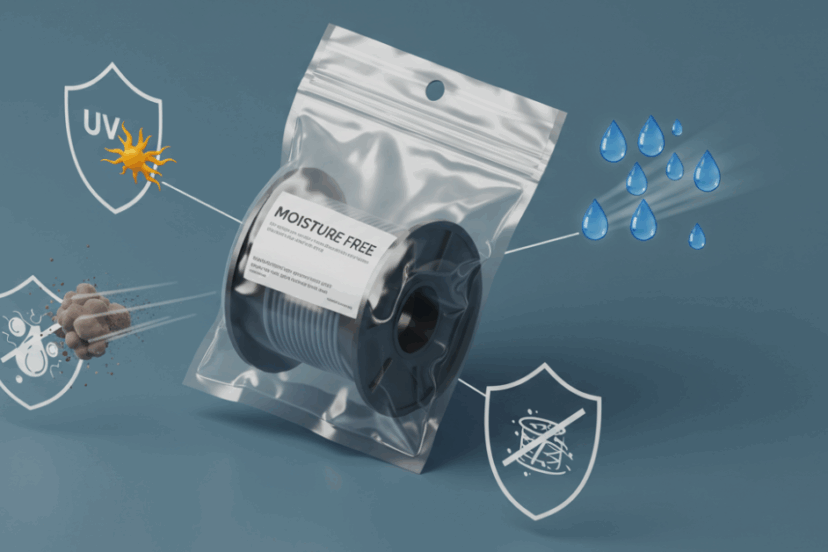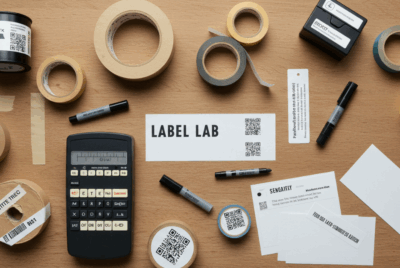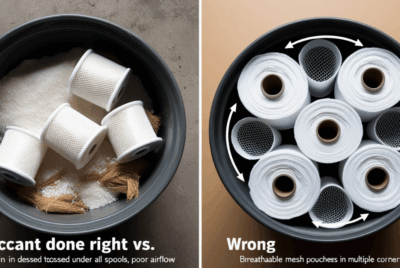How Does Vacuum-Sealing Affect the Long-Term Stability of Filament Properties?
Vacuum-sealing is one of the most effective ways to preserve the quality of 3D filament over time. By creating an airtight environment and protecting the filament from moisture, air, and contaminants, vacuum-sealing helps maintain the long-term stability of filament properties. Let’s explore how vacuum-sealing can affect the stability of filament properties and how it preserves their quality over extended periods.
1. Prevents Moisture Absorption
What It Means:
- Moisture absorption is one of the most common causes of filament degradation. When filament absorbs moisture from the air, it can lead to issues like bubbling, poor adhesion, stringing, and poor extrusion during printing.
Why It Matters for Long-Term Stability:
- Moisture-sensitive filaments, like Nylon, TPU, and ABS, are particularly vulnerable to moisture damage. If these filaments are exposed to moisture for extended periods, they can absorb enough water to compromise their strength, flexibility, and printability.
How Vacuum-Sealing Helps:
- By vacuum-sealing the filament in a moisture-proof bag, you create an environment that significantly reduces the chance of moisture absorption. The vacuum removes air and prevents humidity from entering, keeping the filament dry and in optimal condition for printing. Benefit:
- Prevents moisture-related issues, ensuring the filament retains its original strength, flexibility, and print quality even after long periods of storage.
2. Maintains Filament Integrity and Shape
What It Means:
- Filament spools are often wound tightly to ensure consistent feeding through the 3D printer’s extruder. Over time, improper storage can cause deformation or warping of the filament spool.
Why It Matters for Long-Term Stability:
- Deformed or improperly wound spools can result in tangling, difficulty feeding, or inconsistent extrusion. This compromises the printing process and the filament’s overall usability.
How Vacuum-Sealing Helps:
- Vacuum-sealing helps preserve the shape of the filament spool by minimizing physical stress during storage. The bag holds the spool tightly but does not apply excessive pressure, which helps maintain the filament’s shape over time.
Benefit:
- By preserving the integrity and shape of the filament, vacuum-sealing ensures that the filament will feed smoothly into the printer without any issues related to deformation or tangling.
3. Protects Against UV Degradation
What It Means:
- UV light can degrade filament over time, particularly for PLA, which is sensitive to light exposure. UV degradation causes the filament to become brittle and weak, leading to poor print quality.
Why It Matters for Long-Term Stability:
- UV exposure can lead to color fading, embrittlement, and loss of printability. Keeping filament out of direct sunlight is crucial for long-term preservation, especially for filaments that are sensitive to UV rays.
How Vacuum-Sealing Helps:
- While vacuum-sealing doesn’t block all UV light, it does reduce the filament’s exposure to light. When combined with storage in a dark place, the vacuum-sealed bags help minimize the risk of UV degradation.
Benefit:
- Prevents UV degradation, keeping the filament strong and usable even after long-term storage, particularly for light-sensitive filaments like PLA.
4. Protects from Contaminants and Dust
What It Means:
- Dust and contaminants in the air can settle on the filament, leading to clogs, poor layer adhesion, and other printing issues. Over time, contaminants can also affect the filament’s surface quality and overall performance.
Why It Matters for Long-Term Stability:
- If the filament is stored in an environment where dust and debris can accumulate, these particles can interfere with the extrusion process, leading to printing defects.
How Vacuum-Sealing Helps:
- Vacuum-sealing provides a clean, airtight environment for filament, ensuring that it remains free from dust, dirt, and other contaminants. The bag is sealed tight, preventing external particles from coming into contact with the filament.
Benefit:
- Keeps the filament clean and protected from contaminants, ensuring that the filament performs at its best when you’re ready to print.
5. Minimizes Oxidation and Chemical Degradation
What It Means:
- Oxidation can occur when filament is exposed to oxygen over time, which can lead to chemical degradation. This is particularly true for filaments made from hydroscopic materials like Nylon and ABS.
Why It Matters for Long-Term Stability:
- Oxidation can cause the filament to brittle, affecting its strength, flexibility, and overall printability. Even exposure to air over time can lead to chemical changes in the filament’s composition.
How Vacuum-Sealing Helps:
- Vacuum-sealing removes most of the air, including oxygen, from the bag, creating an oxygen-free environment. This helps prevent oxidation and chemical degradation, particularly for moisture-sensitive filaments that are more prone to these issues.
Benefit:
- Reduces oxidation and chemical degradation, ensuring the filament retains its quality and printability for a longer period.
6. Extends Shelf Life of Filament
What It Means:
- The shelf life of 3D filament refers to how long the filament can be stored before it starts to degrade and lose its effectiveness. Filament can last anywhere from months to years if stored properly.
Why It Matters for Long-Term Stability:
- Improper storage can cause filament to lose its properties, affecting its ability to print well. Filament exposed to moisture, dust, or UV light will degrade much faster than filament kept in a controlled, moisture-free environment.
How Vacuum-Sealing Helps:
- Vacuum-sealing creates an airtight, moisture-free environment, significantly extending the shelf life of filament. By protecting the filament from external factors, vacuum-sealing ensures that the filament remains in optimal condition for longer periods.
Benefit:
- Extends the shelf life of your filament, ensuring it stays ready for use even after long-term storage, saving you money by preventing wasted filament.
7. Reduces the Need for Frequent Drying
What It Means:
- Filament that absorbs moisture requires drying before use. Nylon, TPU, and other moisture-sensitive filaments are especially prone to absorbing water from the air, leading to the need for frequent drying to restore printability.
Why It Matters for Long-Term Stability:
- Frequent drying can lead to filament degradation and weakening over time. The more moisture a filament absorbs, the more fragile it becomes, increasing the risk of poor print quality.
How Vacuum-Sealing Helps:
- Vacuum-sealing eliminates the potential for moisture absorption by creating a dry, airtight environment. This reduces the need for re-drying filament and ensures that the filament remains moisture-free and stable.
Benefit:
- Reduces the need for frequent drying, keeping filament in optimal condition without the risk of degradation from repeated drying cycles.
Summary of How Vacuum-Sealing Affects Long-Term Stability of Filament Properties:
| Factor | Effect of Vacuum-Sealing |
|---|---|
| Moisture Protection | Keeps filament dry by removing air and moisture. |
| Filament Shape | Maintains the integrity and shape of filament spools. |
| UV Protection | Minimizes UV degradation, preserving filament strength and color. |
| Dust and Contaminants | Keeps filament free from dust and dirt, ensuring clean prints. |
| Oxidation | Prevents oxidation, preserving filament quality and flexibility. |
| Shelf Life | Extends shelf life, ensuring filament remains usable for longer. |
| Drying Needs | Reduces the need for frequent drying, preserving filament quality. |
Conclusion:
Vacuum-sealing is an excellent method for preserving the long-term stability of 3D filament properties. By protecting the filament from moisture, physical damage, UV light, and oxidation, vacuum-sealing helps maintain the filament’s strength, flexibility, and printability over extended periods of storage. With the added benefit of reducing the need for frequent drying, vacuum-sealing ensures that your filament remains in optimal condition, ready for high-quality prints whenever you need it.




